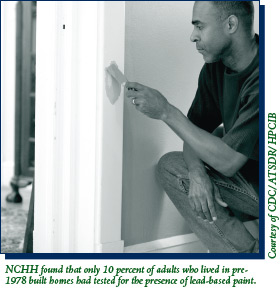November 2009
In this Issue
Paying for Energy Infrastructure Upgrades
Powered by the Sun
The Health of Our Cities’ Housing
Reevaluating Affordable Housing Policy Tools
In the next issue of ResearchWorks
The Health of Our Cities’ Housing
The National Center for Healthy Housing (NCHH) has conducted the first assessment of the health of housing in America’s cities. The assessment focuses on 20 housing conditions closely associated with health and safety problems. NCHH further explored consumer awareness and attitudes pertaining to the healthiness of their domiciles.

For a measure of housing health, NCHH drew on American Housing Survey (AHS) data collected for HUD by the Census Bureau. The AHS is the most detailed, national housing sample survey in the United States that regularly updates housing statistics. National data are collected every other year from a fixed sample of about 50,000 homes, plus new construction. The survey began in 1973 and has maintained the same sample since 1985, permitting users to see changes in homes and households over time. Additional samples are surveyed every 4 to 6 years in some metropolitan areas to measure local conditions. The AHS variables selected by the NCHH for its study of housing conditions that are potential health and safety risks to residents are as follows:
Holes in floors and walls
Open cracks in walls
Broken plaster, peeling paint
Signs of mice
Signs of rats
Water leaks from inside
Water leaks from outside
Water supply stoppage
Flush toilet breakdown
Sewage disposal breakdown
Incomplete plumbing
Exposed wiring in unit
Room heater without flue
Heating equipment breakdown
Roofing problems
Siding problems
Window problems
Foundation problems
Lacking kitchen facilities
Rooms without electrical outlets
Analysts have created a rating system based on AHS data collected on these conditions between 1998 and 2007 for 45 metropolitan statistical areas and 44 of their central cities. Housing in these localities was ranked in two ways, with composite scores for health and overall quality. For example, Charlotte, North Carolina — the metropolitan area with the highest healthy housing score — ranked average or better in 19 of the 20 housing conditions evaluated. Although 31.6 percent of Charlotte’s metropolitan area housing has at least one identified problem, fewer owner-occupied homes (28.6%) than rental homes (39%) possess at least one health or safety risk, which reflects the discrepancy between rental and non-rental housing conditions nationwide. The Charlotte metropolitan area ranks ninth in overall quality of housing. This information is valuable to researchers and students of housing affairs, and to local planners and policymakers who must prioritize the allocation of resources.
Overall, of the homes surveyed nationwide…
- 42 percent had at least one healthy housing problem;
- 11 percent had water leaks from the outside;
- 8 percent had water leaks from the interior;
- 6 percent had roofing problems;
- 5 percent had damage to interior walls;
- 5 percent had signs of mice;
- Rental properties had more problems than owner-occupied homes; and
- Central city housing had more problems than other homes.
In a related study, NCHH sponsored a July 2009 telephone survey of 1,000 adults regarding their perceptions of healthy housing issues, how they understand common health and safety risks in the home, and how they cope with these hazards. The poll included the AHS-based measures noted above, which were supplemented with questions on radon, smoking, roaches, toxic cleaning materials, and other health-related concerns. Surveyors learned that, although most respondents realized that conditions in homes could have health and safety implications, many have not acted to eliminate such risks. For example, only two-thirds (68%) check their smoke alarm twice a year, less than half (41%) have repaired water damage or plumbing leaks, and just 10 percent of those in homes built before 1978 have tested for the presence of lead-based paint.
Almost half (49%) of the respondents reported living with one or more health or safety hazards, such as a dwelling that is too warm (24%) or cold (19%), pests such as roaches or rodents (14%), mold problems (11%), electrical problems (10%), aggravations to allergies or asthma (10%), or dampness and mustiness (8%). When making home improvements, however, respondents tended to give greater priority to saving money, improving a home’s value, and making a home more energy efficient than they did to making their home safer and healthier. The results of these studies clearly indicate that Americans can do more to create and maintain safer, healthier homes.
The results of NCHH’s assessment, State of Healthy Housing, are available online at www.nchh.org/ Policy/State-of-Healthy-Housing.aspx and the 2009 Consumer Survey can be read or downloaded at www.nchh.org/LinkClick.aspx?fileticket=uOQnnhazFrs%3d&tabid=368. Both tools can help localities decide how best to improve the health and safety of their existing and new housing.

